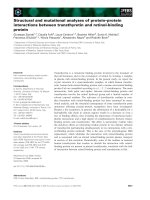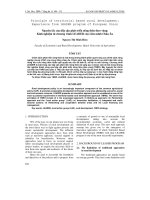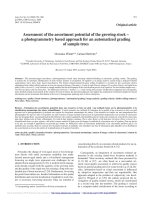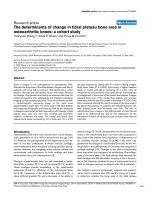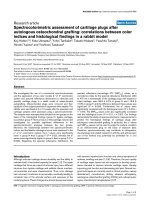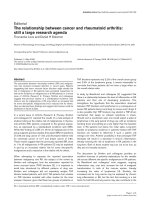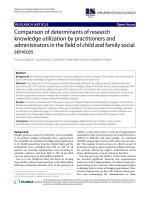Analyzing the determinants of dervice trade flows between Vietnam and the european union: A gravity model approach
Bạn đang xem bản rút gọn của tài liệu. Xem và tải ngay bản đầy đủ của tài liệu tại đây (266.48 KB, 14 trang )
VNU Journal of Science: Economics and Business, Vol. 30, No. 5E (2014) 51-64
Analyzing the Determinants of Service Trade Flows Between
Vietnam and the European Union: A Gravity Model Approach
Phạm Văn Nhớ, Vũ Thanh Hương*
VNU University of Economics and Business,
144 Xuân Thủy Str., Cầu Giấy Dist., Hanoi, Vietnam
Received 17 November 2014
Revised 25 November 2014; Accepted 25 December 2014
Abstract: This paper analyzes the determinants of service trade flows between Vietnam and the
European Union. In this respect, a gravity model has been estimated with panel data and pooled,
random and fixed effect estimation, covering the period of ten years from 2002 to 2011, for total
service trade flows, service exports, and service imports between Vietnam and the European Union
separately. The estimated results indicate that the service trade flows between Vietnam and its
European partner countries are determined by the GDP per capita gap between Vietnam and EU
countries, the population of EU countries, the real effective exchange rates, colonial relationship
and being former members of the Council of Mutual Economic Assistance.
Keywords: Gravity model, service trade, Vietnam, EU.
1. Introduction*
Vietnamese government has also implemented
comprehensive policies to accelerate the
development of high-value-added services.
In Vietnam, the service industry has played
an important role in the socio-economic
development of the country, and has contributed
significantly to its economic growth. Since 2005,
the growth of Vietnam’s service sector has
exceeded total GDP growth. In 2013, the service
sector of Vietnam grew by 6.57%, accounting
for 43.9% of the country’s GDP, and created
employment for 16.7 million persons [1]. From
the perspective of the government of Vietnam,
the service industry is a vital part of Vietnam’s
strategy to become a modern economy by 2020.
Therefore, the service sector is targeted to grow
by 8-8.5% per year and account for 42-43% of
Vietnam’s GDP during 2016-20201. The
In Vietnam, trade in services has accounted
for less than 10% of total trade, although the
service sector has accounted for the largest
share in GDP. The value of services trade has
more than doubled since 2007 but its share in
total trade has decreased quite significantly
because trade in goods has grown faster than
trade in services during that time. Among
Vietnam’s trade partners, the European Union
(EU) has been recognized to be one of the most
important markets over time. In terms of trade
in goods, the EU has been the biggest importer
of Vietnamese products since 2012, with an
import value of nearly USD 24.5 billion. The
EU is also the fifth biggest exporter to
Vietnam with an export value of around USD
9.5 billion in 2013 [2, 3]. However, the EU’s
_______
*
Corresponding author. Tel.: 84-977917656
E-mail:
1
Decision No. 175/QD-TTg dated January 27, 2011 on
Approving Vietnam’s Overall Service Sector Development
Strategy by 2020.
51
52
P.V. Nhớ, V.T. Hương / VNU Journal ofScience:Economics and Business, Vol. 30, No. 5E (2014) 51-64
trade in services with Vietnam has been
relatively small compared to its trade in
goods with Vietnam. This raises the question
as to whether service trade between the EU
and Vietnam in the near future can be
potentially much higher than the present
level, and what would be the determinants of
this potential change.
2. An overall view of Vietnam - EU trade
in services
The objectives of this paper are two fold.
Firstly, it aims at providing an overview picture
of trade in services between Vietnam and the
EU. Secondly, it attempts to analyze the
determinants of that service trade flow using the
gravity model approach. The paper is structured
as follows. After the introduction, Section 2
provides a picture of Vietnam - EU trade in
services. Section 3 presents the gravity model
approach used in this paper and reviews the
existing literature on gravity model applications
to services. In section 4, the gravity model is
used to estimate the services trade between
Vietnam and the EU and then the results and
findings are discussed. Section 5 is the
conclusion part.
In this period the EU’s service trade in total
service trade with Vietnam was quite stable and
relatively large, around 17-21%, except for the
year 2009 when the share went up to over 25%.
This is because there was a significant decrease
in the total trade in Vietnam’s services in 2009
due to the global economic downturn while the
Vietnam-EU service trade flows still increased,
despite the crisis.
Over the period 2006-2012, the bilateral
trade flows of services between Vietnam and
EU have more than doubled from over USD
1,773 million in 2006 up to USD 3,650 million
in 2012 (Figure 1).
Although Vietnam hada deficit in service
trade with the world consistently in 2006-2012,
it enjoyed a surplus in service trade with the EU
in several years - about USD 420 million in
2006, over USD 190 million in 2008, nearly
USD 280 million in 2011 and above USD 140
million in 2012 (Figure 2).
j
Figure 1: Bilateral service trade between Vietnam and the EU, 2006-2012.
(Unit: million USD)
Source: EBOPS 2002 - OECD Database (2014) and Trade Map Database (2014)
f
P.V. Nhớ, V.T. Hương / VNU Journal ofScience:Economics and Business, Vol. 30, No. 5E (2014) 51-64
53
Figure 2: Vietnam’s service trade balance with the EU, 2006-2012
(Unit: million USD)
Source: EBOPS 2002 - OECD Database (2014).
Most of the growth in bilateral service trade
between Vietnam and the EU can be attributed
to the increase in service trade between
Vietnam and France, the United Kingdom, the
Netherlands, Denmark and Germany (Figure 3).
These five countries accounted for over 65% of
the total Vietnam - EU service trade flows in
2006 and nearly 62% in 2012. Among these
five countries, France was the largest service
trade partner with Vietnam, with the bilateral
trade being USD 415 million in 2006 and USD 913
million in 2012, accounting for more than 23% and
26% of the total Vietnam - EU service trade,
respectively. The respective numbers for the
United Kingdom, the second largest partner, were
USD 218 million and USD 442 million in 20122.
Figure 3: Top 5 EU countries in trade in services with Vietnam, 2006-2012
(Unit: million USD)
2
Source: EBOPS 2002 - OECD Database (2014).
_______
2
Data on Vietnam’s service imports from Germany is available while data on Vietnam’s service exports to Germany is not.
Therefore, in reality, the rank of Germany in the top 5 might be higher.
54
P.V. Nhớ, V.T. Hương / VNU Journal ofScience:Economics and Business, Vol. 30, No. 5E (2014) 51-64
3. The gravity model and its application for
trade in services
3.1. The gravity model
The gravity model was firstly applied to
examine international trade flows by Tinbergen
[4]. Since then, it has become a useful tool in
international trade literature, especially with a
renewed interest among economists in
geography and the impacts of distance on
international trade. There are several theoretical
foundations for the gravity equation ranging
from that of Anderson [5] to Bergstrand [6],
both of whom modeled the value of bilateral
trade flows as a function of income and
transport costs.
Subsequently, it has been widely
recognized that the gravity equation can be
derived from different models, including the
Ricardian model, Heckscher-Ohlin theory, and
the
monopolistic
competition
model.
Specifically, Helpman and Krugman [7]
showed that the gravity equation can be derived
from the monopolistic competition model with
increasing returns to scale, whereas Deardorff
[8] indicated that it can also be derived from the
Heckscher-Ohlin model without assuming
product differentiation. Eaton and Kortum [9]
derived a gravity-type equation from the
Ricardian type of model, and Helpman et al.
[10] and Chaney [11] obtained it from a
theoretical model of international trade in
differentiated goods with firm heterogeneity.
In its general formulation, the gravity
equation has the following multiplicative form:
X ij = GS i M j eij
Where Xij is the monetary value of exports
from Nation i to Nation j, Mj denotes all
importer-specific factors that make up the total
importer’s demand (such as the importing
country’s GDP) and Si comprises exporter-
specific factors (such as the exporter’s GDP)
that represent the total amount exporters are
willing to supply. G is a variable that does not
depend on i or j such as the level of world
liberalization. Finally, eij represents the ease of
exporter i to access the market j (that is, the
inverse of bilateral trade costs)3.
3.2. Application of the gravity model for trade
in services
Over the last 40 years, there have been a lot
of studies using the gravity model to investigate
trade flows. However, most studies have paid
more attention to using the gravity model for trade
flows of goods rather than flows of services.
Can the gravity model be used to study
service trade? Arguably, the gravity model
would appeal more to service trade than goods
trade as the physical proximity between
producers and consumers is very important for
certain types of service trade. Secondly, service
products are often differentiated by quality and
location, which may give rise to monopolistic
competition. Thirdly, the market for services is
often characterized by asymmetric information
where reputation and signaling play a central
role. In a gravity model setting, if trade costs
increase with distance, the elasticity of exports
with respect to distance will be higher in sectors
such as services where fixed market
investments are important.
The existing literature on the application
of the gravity model to services trade is so far
quite limited. One of the first papers on the
subject was that of Francois [12], who models
the demand for imports of services as a
function of the recipient country’s GDP per
_______
3
See Bacchetta, M., C. Beverelli, O. Cadot, M. Fugazza,
J. M. Grether, M. Helble, A. Nicita, and R. Piermartini,
“Chapter 3: Analyzing Bilateral Trade using the Gravity
Equation”, in A Practical Guide to Trade Policy Analysis,
United Nations and World Trade Organization for more
information, 2012.
P.V. Nhớ, V.T. Hương / VNU Journal ofScience:Economics and Business, Vol. 30, No. 5E (2014) 51-64
capita and population based on data taken
from the Global Trade Analysis Project
(GTAP) database. In an extension of this
approach, Park [13] also uses service data
from the GTAP to calculate tariff equivalence
for a larger selection of countries and sectors.
The gravity model is modified to include
price indices to capture differences in prices
between countries. With the publication of
the OECD database, Grunfeld and Moxnes
[14], Kimura and Lee [15], Lejour and
Verheijden [16], Mirza and Nicoletti [17],
Kox and Lejour [18], Lennon [19] and Walsh
[20], have all used this dataset to assess
determinants of bilateral services trade using
the gravity framework.
Grunfeld and Moxnes [14] apply a gravity
model to the bilateral export of services and
FDI flows using data from the OECD. Their
regression includes the level of GDP and GDP
per capita in the importing and exporting
countries, the distance between them, a dummy
variable if they are both members of a free trade
area (FTA), a measure of corruption in the
importing country, and a trade restrictiveness
index (TRI4) to measure the barriers to services
trade in the importing country. Their results
suggest that the standard gravity model effects
found in studies on trade in goods can be
applied to service trade too. Service trade
between two countries is positively related to
their size and negatively related to the distance
between them and to barriers to services in
place in the importing country.
Kimura and Lee [15] use a mix of OLS and
fixed effects for time to compare trade in goods
with that in services in a gravity model setting.
As with Grunfeld and Moxnes [14], they use
the OECD statistics on trade in services. They
add someof the standard gravity model
variables, including adjacency and language
_______
4
The TRI is the augmented frequency index based on
research by the Australian Productivity Commission.
55
dummies, and additionally include a measure of
remoteness as a regressor. They find that
distance between trading partners is more
important in service trade than in goods trade
and suggest that this implies higher transport
costs for services, but fail to provide any reason
why this may be the case.
Lejour and Verheijden [16] also compare
the gravity model estimate for trade in goods
and services, examining intra-regional trade in
Canada and the EU using the OECD services
trade statistics and data from the official
Canadian statistical agency. Unlike Kimura and
Lee [15], distance is found to be less important
for services compared to goods. Lennon [19]
compares trade in goods and services with a
focus on the commercial services sector of the
OECD database and finds distance and
adjacency to be less significant for trade in
services than in goods, and common language
and RTAs to be more important for services
trade. The impact of the latter, however, is
found to be insignificant with GDP per capita
included in the estimation.
Walsh [20] uses the Hausman-Taylor
method (HTM) to estimate a gravity model for
services trade and finds the wealth of countries
and a common language to be the most
important determinants of services trade. The
impact of distance is generally found to be
insignificant. A measure of services
restrictiveness based on the TRI is also found to
be weakly significant.
As can be seen, there is a general lack of
consensus on the key findings in the literature
analyzing the determinants of services trade
using gravity-based approaches. For instance,
Kimura and Lee [15] find distance to be more
important for services trade while Lejour and
Verheijden [16] and Lennon [19] report the
converse to be true. Walsh [20], on the other
hand, finds the impact of distance to be
56
P.V. Nhớ, V.T. Hương / VNU Journal ofScience:Economics and Business, Vol. 30, No. 5E (2014) 51-64
insignificant. However, what is more important
is that the previous literature has laid out the
foundation for application of the gravity model
to service trade that will be applied in this paper
to construct a gravity model for Vietnam in
service trade with the EU.
3.3. Application of gravity model for trade
in Vietnam
In Vietnam, there are also several studies
using the gravity model to analyze international
trade flows as well as the bilateral trade flows
of Vietnam. Do Tri Thai [21] applies the
gravity model in order to explain bilateral trade
flows between Vietnam and 23 European
countries from 1993 to 2004. His regression
includes GDP and population of exporting and
importing countries, real exchange rate and
distance between them and a history dummy
variable. He finds that the determinants of
bilateral trade between Vietnam and the
European countries are economic size (GDP),
market size (population) and the real exchange
rate volatility. However, distance and history
seem to have no effect.
Nguyen Xuan Bac [22] also uses the gravity
model to analyze the exporting flows of
Vietnam with the dependent variable being the
exporting value from Vietnam to other
countries during the 20 year period up to 2006.
After regressing both static and dynamic
models, he find that there is a strong correlation
between the Vietnamese contemporary export
flows and those of the previous year, and that
the value of export from Vietnam to other
countries has a positive relationship with GDP,
exchange rate and the partner being in ASEAN,
and is negative with distance.
Dinh Thi Thanh Binh, Nguyen Viet Duong
and Hoang Manh Cuong [23] use the gravity
model to analyze bilateral trade activities
between Vietnam and 60 countries in the period
from 2000 to 2010 with the database of the
ITC, the IMF and the WB. Their results suggest
that the bilateral trade flows between Vietnam and
60 countries were strongly affected by the
economic size of Vietnam, the economic size and
market sizes of partners, distance and culture.
However, it is worth noting that studies
using a gravity - based approach in Vietnam so
far have only focused on trade in goods. There
is a lack of studies applyingthe gravity model to
analyze trade flows in services of Vietnam.
Therefore, the aim of this paper is to usethe
gravity model to analyze the service trade of
Vietnam and to specifically examine the
determinants of the services trade of Vietnam
with the EU.
4. Data analysis and findings
4.1. Estimation model and data source
The gravity model used for estimation in this
paper is presented in equation (1), in which all
continuous variables are expressed in logarithms.
lnTijt = aij + a1lnGDPPCGAPijt + a2lnPOPit +
a3lnPOPjt + a4lnDISTANCEij + a5lnREERijt +
a6CONOLYij + a7CMEAj + eijt
Equation (1) issued to estimate total
services trade (exports plus imports), service
exports and service imports separately.
Therefore, the dependent variable lnTijt is the
logarithm of total services trade, services
exports and services imports between Vietnam
and EU partner country j at time t.
The first continuous variable is the
difference between the GDP per capita of
Vietnam and the GDP per capita of the EU
partner country j at time t, GDPPCGAPijt. The
GDP per capita gap is created by taking the
GDP per capita of the EU partner country and
subtracting the GDP per capita of Vietnam.
P.V. Nhớ, V.T. Hương / VNU Journal ofScience:Economics and Business, Vol. 30, No. 5E (2014) 51-64
Since the GDP per capita of the EU partner
countries is much higher than that of Vietnam,
GDP per capita gaps always take the positive
sign and thus logarithms can be taken. The
coefficient of the GDP per capita gap is
expected to take either a positive or negative
sign because the impact of the GDP per capita
gap on total services trade is not straightforward
in the literature.
The coefficients on the population of
Vietnam and EU countries at time t, POPit and
POPjt respectively, are expected to take either a
negative or positive sign. As Zarzosa and
Lehmann (2002) show, population size may
have a negative effect on export if countries
export less as they become larger and rely more
on internal trade, or a positive effect if they
export more as they become larger and are able
to achieve economies of scale. Population size
similarly is expected to have either a positive or
negative sign on imports.
Distance, DISTANCEij, is involved as a
proxy for trade cost between Vietnam and EU
partner countries and is expressed as weighted
distance taken from CEPII. Although distance
between the two countries is typically expected
to have a negative impact on trade in goods, it
is not clear from a review of the existing
literature about the impact of distance on trade
in services. Service products do not have to be
physically transported from location to location.
Depending on the nature of each mode5 of
service trade, the sign of distance might be
positive or negative.
The last continuous variable is the real
effective exchange rate (lnREERijt) between
Vietnam and EU partner countries at time t. The
_______
5
Service trade is conducted through four Modes of supply.
Mode 1: Cross-border supply; Mode 2: Consumption
abroad; Mode 3: Commercial presence; and Mode 4:
Presence of Natural Person.
57
coefficient of real effective exchange rate is
expected to have either a positive or negative
sign, depending on the mode of service trade.
The final two regressors are dummy
variables indicating whether Vietnam and EU
partner countries have ever had a colonial link
(COLONYij) and whether the EU partner
country was a former member of the Council of
Mutual Economic Assistance (CMEAj).
Colonization is used to describe a relationship
between two countries, independently of their
level of development, in which one has
governed the other over a long period of time
and contributed to the current state of its
institutions. The effect of colonial link between
Vietnam and a partner country is expected to be
positive since having a colonial relationship
may promote the trade flows between the two
countries. The last dummy variable is also
expected to have a positive sign, since being
members of the same association would support
and promote the economic and trade
relationship between Vietnam and those partner
countries, not only in the past but also at
present. The dummy variable for COLONYij is
equal to unity if Vietnam and the EU partner
country j were once in a colonial relationship,
and the CMEAj dummy variable is equal to
unity if the partner country was a former
member of the CMEA.
A panel framework is designed to cover
service trade variation between Vietnam and its
European trading partners during a period of ten
years from 2002-2011. Panel estimation in this
paper is done by using pooled OLS estimation,
fixed effect (FEM) and random effect (REM).
The paper conducts the Breusch-Pagan test,
which is applied to REM, comparing it to the
58
P.V. Nhớ, V.T. Hương / VNU Journal ofScience:Economics and Business, Vol. 30, No. 5E (2014) 51-64
pooled OLS estimator. The result of the
Breusch-Pagan test indicates that REM is a
better estimator than OLS. The Hausman test is
also applied to REM and FEM, showing that
REM is better than FEM.
Concerning the data source, data on
Vietnam’s imports and exports of services with
each of 27 EU partners are extracted from the
OECD database on international trade in
services. Data on GDP per capita (in current
USD) and population variables are drawn from
the World Development Indicators database.
The distance used in this paper is weighted
distance taken from CEPII’s database on
distance. This distance is calculated between
two countries based on bilateral distance
between the biggest cities of those two
countries, those inter-city distances being
weighted by the share of the city in the
country’s overall population. The data on the
real effective exchange rate index (2005 = 100) of
Vietnam and EU partner countries are taken from
the World Development Indicators Data and
collected for the period of 10 years from 2002 to
2011 with 270 observations in the dataset.
The summary statistics for each of the
variables is shown in Table 1.
4.2. Results and findings
Since the test results reveal that REM is the
best estimator, this section focuses only on REM
estimation. The estimation results of equation (1)
for total service trade (exports plus imports)
between Vietnam and EU are given in Table 2.
As shown in Table 2, when the gravity
model is estimated using REM for total services
trade (Column 3), all variables except distance
and population of Vietnam are 1% statistically
significant and their coefficients take the signs
that would be expected from the standard
gravity literature. The model fits data relatively
well with R2 at 57.8%, which means that the
dependent variables explain nearly 60% of the
observed variations in total service trade
between Vietnam and EU.
Table 1: Summary statistics
Variable
IMPORTijt
Mean
39360.3
Std. Dev.
81633.25
EXPORTijt
32436.46
TRADEijt
Min
1
Max
524200
97675.43
1
750670
71796.29
162561.5
1
1046770
GDPPCGAPijt
27.24949
19.43542
1.55368
110.864
POPit
8.37E+07
2650941
7.95E+07
8.78E+07
POPjt
1.84E+07
2.28E+07
395969
8.25E+07
DISTANCEij
9061.271
812.1724
7629.566
11140.04
COLONYij
0.037037
0.1892033
0
1
REERijt
0.9072721
0.1203427
0.6967219
1.502877
CMEAj
0.2592593
0.4390419
0
1
Source: Calculation of the authors from the dataset.
P.V. Nhớ, V.T. Hương / VNU Journal ofScience:Economics and Business, Vol. 30, No. 5E (2014) 51-64
59
Table 2: Estimated results for total Vietnam - EU service trade equation
(1)
(2)
(3)
Pooled OLS
Fixed effect
Random effect
Dep. var
LnTRADE
LnPOPit
LnPOPjt
23.259
4.971
(7.989)
(14.497)
(9.645)
***
**
0.514***
(0.162)
(0.112)
(0.149)
***
1.742
3.905***
(0.317)
(1.598)
(0.592)
***
*
7.604***
(2.959)
(2.339)
0.812
LnGDPPCGAP
LnREER
1.430
4.873
4.435
0.240
5.353
(1.704)
LnDISTANCE
COLONY
CMEA
_cons
Observations
2
R
**
-3.477
(3.449)
(9.291)
***
4.901***
(0.580)
(0.862)
***
3.716***
(0.595)
(1.313)
-8.199
4.389
3.901
26.650
-426.425
-72.940
(153.584)
(261.058)
(204.088)
270
270
270
0.591
0.245
0.578
Robust standard errors in parentheses.
*
significant at 10%; ** significant at 5%; *** significant at 1%.
Source: Calculation of the authors from the dataset.
Firstly, the population of EU countries
rather than that of Vietnam is found to have a
high significance and a positive influence on
total service trade. An increase of 1% in the
population of EU nations tends to enhance
Vietnam - EU service trade flows by
approximately 0.5%. The positive relationship
between the population of EU countries and
service trade flows indicates that EU countries
trade more with Vietnam in services when its
market size becomes larger. It is, however,
worth noting that population of Vietnam does
not
have
an
influence
on
service
tradestatistically. This might be explained by
the fact that EU consumers have a relatively
high proportionate demand for services while
the consumption pattern of Vietnamese
consumers is more proportionate to daily
consumption such as eating, drinking and
smoking6. Therefore, the increase in the
_______
6
Based on Vietnam Household Living Standards,
surveyed annually.
60
P.V. Nhớ, V.T. Hương / VNU Journal ofScience:Economics and Business, Vol. 30, No. 5E (2014) 51-64
population of Vietnam is not the vital reason for
an increase in the EU’s service exports to
Vietnam, while the reverse holds true. In
addition, it might imply that the EU trades in
services with Vietnam because of the
differences in service quality and comparative
advantages rather than market size.
Secondly, the coefficient of the GDP per
capita gap is 1% statistically significant and has
a positive sign. Specifically, if the GDP gap
increases by 1%, the bilateral service trade
flows will go up by roughly 4%. This implies
that the larger the difference in GDP per capita
between Vietnam and partner countries is, the
bigger the volume of services Vietnam trades
with these nations. In other words, Vietnam
tends to trade more with countries that have
high income per capita. This finding is opposite
to the Linder hypothesis7,but absolutely
consistent with Lee et al. [24] who state that
countries with a similar level of income per
capita trade less with each other, or an increase
in GDP per capita gap will increase the bilateral
service trade flows. This is because if both
countries have comparable services, then the
net gains from service trade may be negligible,
and domestic service is likely to replace service
trade.This effect depresses the service trade
between similar countries.
Thirdly, the real effective exchange rate is
found to have a strong and positive impact on
total service trade. An increase of 1% in the real
effective exchange rate will boost the value of
service trade between Vietnam and the EU by
about 7.6%. This might be explained by the fact
that like most of the other nations in the world,
service trade through establishing commercial
_______
7
The Linder hypothesis originates from the premise that
countries with similar capital incomes tend to trade more
with each other in manufacturing goods. Lee et al. (2012)
conclude that the Linder hypothesis does not hold for
service trade.
presence (Mode 3) and consumption abroad8
(Mode 2) is the most prevailing in Vietnam.
Therefore, if the real effective exchange rate
increases, it will encourage foreign service
enterprises to set up a commercial presence in
Vietnam to provide services or foreign
tourists to travel to Vietnam. In fact, tourism
has been among the biggest exporting service
sectors of Vietnam.
Fourthly, distance is another explanatory
variable that is statistically insignificant. This
finding is not surprising and in line with the
suggestion of Walsh (2006). Unlike trade in
goods that requires physical movement of goods
across borders, trade in services does not
necessarily require services to be physically
transferred across nations. Depending on the
nature of the service, in some cases service trade
will require movement of a physical person but in
others services may be provided electronically.
Fifthly, the coefficient of colony is 1%
statistically significant with a positive sign. The
positive coefficient indicates that the service
trade flows between Vietnam and EU nations is
strongly supported by the colonial link.
Amongst reported EU partner countries, France
is the only country that once had a colonial link
with Vietnam. Therefore, it is not surprising
that France has been the largest services trade
partner of Vietnam for years.
The last variable, CMEA, also has the
expected sign and statistical significance. The
positive coefficient of CMEA implies that
being a former member of CMEA will
positively influence the service trade flows
between these countries and Vietnam.
In an attempt to further the interpretation,
equation (1) is used to estimate the service
exports and service imports of Vietnam with
EU partners. The estimation results using the
REM model are given in Table 3.
_______
8
That is foreign tourists travel to Vietnam.
P.V. Nhớ, V.T. Hương / VNU Journal ofScience:Economics and Business, Vol. 30, No. 5E (2014) 51-64
61
Table 3: Estimated results on services exports and services imports
(1)
(2)
(3)
Dep. Var
LnTRADE
LnEXPORT
LnIMPORT
LnPOPit
4.971
12.456
-1.361
(9.645)
(10.369)
(9.152)
***
0.220*
0.470***
(0.149)
(0.132)
(0.176)
3.905***
2.285***
3.844***
(0.592)
(0.806)
(0.658)
7.604***
5.129**
7.625***
(2.339)
(2.371)
(2.172)
-3.477
0.029
-2.660
(9.291)
(9.235)
(8.826)
***
***
4.957***
(0.862)
(0.997)
(1.089)
***
1.036
4.173***
(1.313)
(2.319)
(1.359)
-72.940
-232.449
35.025
(204.088)
(211.990)
(206.817)
270
0.578
270
0.374
270
0.569
LnPOPjt
0.514
LnGDPPCGAP
LnREER
LnDISTANCE
COLONY
CMEA
4.901
3.716
_cons
Observations
R2
6.017
Robust standard errors in parentheses.
*
significant at 10%; ** significant at 5%; *** significant at 1%.
Ln(EXPORT): Service Exports of Vietnam to EU.
Ln(IMPORT): Service Imports of Vietnam from EU.
Source: Calculation of the authors from the dataset.
The estimated coefficients for Vietnam EU service exports are shown in Column 2 and
service imports in Column 3. As can be seen,
the estimated results for service exports and
service imports are quite consistent with those
for total service trade, and the service imports
fits the data better than do services exports.
while CMEA is found to have no impact on
service exports.Population of EU member
countries, the GDP per capita gap and real
effective exchange rate are found to have
greater impacts on service imports than service
exports, whereas the opposite is true for
colonial link.
Population of Vietnam and distance are the
only two variables that also do not have impact
on both service exports and service imports,
The difference in GDP per capita has greater
impact on Vietnam’s service imports than service
exports, which implies that a 1% increase in the
62
P.V. Nhớ, V.T. Hương / VNU Journal ofScience:Economics and Business, Vol. 30, No. 5E (2014) 51-64
GDP gap makes Vietnam import more from than
export to the EU. Therefore, an implication is that
if Vietnam follows a mercantilist approach,
Vietnam should promote trade more with EU
countries that have a lower GDP.
In addition, it is worth noting that real
effective exchange rate has a positive influence
on both service export and service import. This
finding is quite interesting, but it is consistent
with Vietnam’s service trade pattern, by which
Vietnam mostly exports travel services through
Mode 2 and imports commercial services,
transportation services and insurance services
through Mode 3. In fact, an increase in the
exchange rate will encourage investors to invest
more in Vietnam and foreign tourists to travel
to Vietnam. In addition, the results also point
out the real effective exchange rate has greater
impact on Vietnam’s service imports than
service exports.
5. Concluding remarks
In the period 2001-2012, the Vietnam - EU
service trade flow increased dramatically with a
relatively stable and large proportion of around
17-21% of the total service trade of Vietnam. In
addition, Vietnam had a trade surplus in
services with the EU in several years in the
context of service deficits with the whole
world. This shows that besides the importance
of the EU in trade in goods, the EU also plays
an increasingly vital role in Vietnam’s service
trade. Therefore, it is a necessity for Vietnam
to promote trade in services with the EU
which is regarded as being among the bestquality service providers globally in order to
support Vietnam’s on-gong process of
economic re-structuring.
In this paper, a gravity model has been
employed with panel data and pooled, random,
fixed effect estimation covering the period of
ten years from 2002 to 2011 for total service
trade, service exports and service import
separately. The estimated results on the
Vietnam - EU overall service trade, service
imports and service imports all indicate that
bilateral service trade flows between Vietnam
and EU are determined by the GDP per capita
gap, the population of EU countries, the real
effective exchange rate, colonial relationship
and being former members of CMEA.
Vietnam’s population and distances between
Vietnam and the EU nations are statistically
insignificant.
The results imply that Vietnam can promote
service trade with the EU based on taking
advantage of the EU’s market size, the GDP
gap between Vietnam and EU nations, and
differences in service quality, comparative
advantage, and trade pattern. For instance,
Vietnam can focus on exporting the service
sector that has been considered to have
relatively comparative advantage such as
tourism and at the same time importing the
high-quality services of the EU such as
transportation, distribution and financial
services. By doing this, customers will most
benefit with a wider range of service selection.
Service enterprises in Vietnam also have big
incentives
to
renovate
and
increase
competitiveness to compete with EU service
providers. All of these changes will drive
Vietnam towards a more modern economic
structure in the future.
Service trade between Vietnam and EU also
depends on exchange rate policy. The model
shows that an increase in real exchange rate will
encourage Vietnam’s service imports more than
service imports from the EU. Therefore, careful
consideration of the exchange rate policy of
both Vietnam and the EU to adopt an
appropriate service trade strategy is of great
P.V. Nhớ, V.T. Hương / VNU Journal ofScience:Economics and Business, Vol. 30, No. 5E (2014) 51-64
importance for Vietnam’s service enterprises.
The model results also implies that if Vietnam
follows a mercantilist approach, Vietnam
should also promote trade more with EU
countries that have a lower GDP gap with
Vietnam. Finally, to promote service trade with
the EU, Vietnam can consider trading with
France, the country that once had a colonial link
with Vietnam, and with CMEA nations.
[7]
This paper in summary examines an overall
picture of Vietnam’s service trade with the EU
and analyzes determinates of these service
flows. This paper in the future can be upgraded
by examining and analyzing determinants of the
Vietnam-EU service trade or Vietnam’s service
trade in general by service sector and Mode, in
order to provide a more comprehensive analysis
and implications for Vietnam in trading in
services with the world.
[10]
[8]
[9]
[11]
[12]
[13]
References
[14]
[1]
[2]
[3]
[4]
[5]
[6]
GSO, Employed population at 15 years of age
and above as of annual 1 July by kinds of
economic activity Statistical data. Hanoi,
Vietnam: General Statistical Office of Vietnam,
2014a.
GSO, Exports of goods by regions, country
group, country and teritory Statistical data.
Hanoi, vietnam: General Statistical Office of
Vietnam, 2014b.
GSO, Imports of goods by regions, group
country, country and territory. Statistical data.
Hanoi, Vietnam: General Statistical Officce of
Vietnam, 2014c.
Timbergen, J., Shaping the World Economy:
Suggestions for an International Economic
Policy, New York: The Twentieth Century
Fund, 1962.
Anderson, J. E., A Theorical Foundation for the
Gravity Equation. American Economic Review
69 (1979) 1, 106-116.
Bergstrand, J., The Gravity Equation in
International Trade: Some Microeconomic
Foundations and Empirical Evidence, The
Review of Economics and Statistics 67 (1985),
474-481.
[15]
[16]
[17]
[18]
[19]
[20]
63
Helpman, E., and P. Krugman, “Market
Structure and Foreign Trade: Increasing
Returns, Imperfect Competition and the
International Economy”, MIT Press, 1985.
Deardorff, V. A., “Determinants of
Bilateral Trade: Does Gravity Work in a
Neoclassical World?”, The Regionalization
of Economy, 1998.
Eaton, J., and S. Kortum, “Technology,
Geography, and Trade”, Econometrica 70
(2002) 5, 1741-1779.
Helpman, E., M. Melitz and Y. Rubinstein,
“Trading Partners and Trade Volumes”,
Quarterly Journal of Economics 123
(2008), 441.
Chaney, T., “Distorted Gravity: The Intensive
and Extensive Margin of International Trade”,
American Economic Review 98 (2008), 1707.
Francois, J., The next WTO Round: North South Stakes in New Markets Access
Negotiations, Adelaide: Centre for International
Economics Studies, 2001.
Park, S. C., “Measuring Tariff Equivalents in
Cross-Border Trade in Services”, Korea
Institute for International Economic Policy
Working Paper 2, 2002.
Grunfeld, L. A. and A. Moxnes, “The Intangible
Globalization: Explaining the Patterns of
International Trade in Services”, Discussion
Paper, 2003, 657.
Kimura, F., and H. H. Lee, The Gravity
Equation in International Trade in Services,
European Trade Study Group Conference,
University of Nottingham, 2004.
Lejour, A. and J. de P. Verheijden, “Services
Trade with Canada and the European Union”,
CPB Discussion Paper, 2004, 42.
Mirza, D., and G. Nicoletti, “What is so
Special about Trade in Services?”, Research
Paper 2004.
Kox, H. and A. Lejour, “Regulatory Heterogeneity
as Obstacle for International Services Trade”,
CPB Discussion Paper, 2005, 49.
Lennon, C., Trade in Services and Trade in
Goods: Differences and Complemetarities,
Conference of the European Trade Study
Group, Vienna, 2006.
Walsh, K., “Trade in Servies: Does Gravity
Hold? A Gravity Model Approach to
Estimating Barriers to Services Trade”, IIIS
Discussion Paper 183, 2006.
64
P.V. Nhớ, V.T. Hương / VNU Journal ofScience:Economics and Business, Vol. 30, No. 5E (2014) 51-64
[21] Do, Tri Thai, A Gravity Model for Trade
between Vietnam and Twenty-three European
Countries, Department of Economics and
Society, 2006.
[22] Nguyen Xuan Bac, “The Determinants of
Vietnamese Export Flow: Static and Dynamic
Panel Gravity Approaches”, International
Journal of Economics and Finance 2 (2010) 4.
J
k
[23] Dinh Thi Thanh Binh, Nguyen Viet Duong and
Hoang Manh Cuong, Applying Gravity Model
to Analyze Trade Activities of Vietnam, 2011.
[24] Lee, S. Y., Jun, S. H. and Kim, D., Does the
Linder Hypothesis Hodl for Servie Trade? Do
Countries of Similar Incomes Trade more with
Each Other for Service Trade? East-West
Center, 2012.

